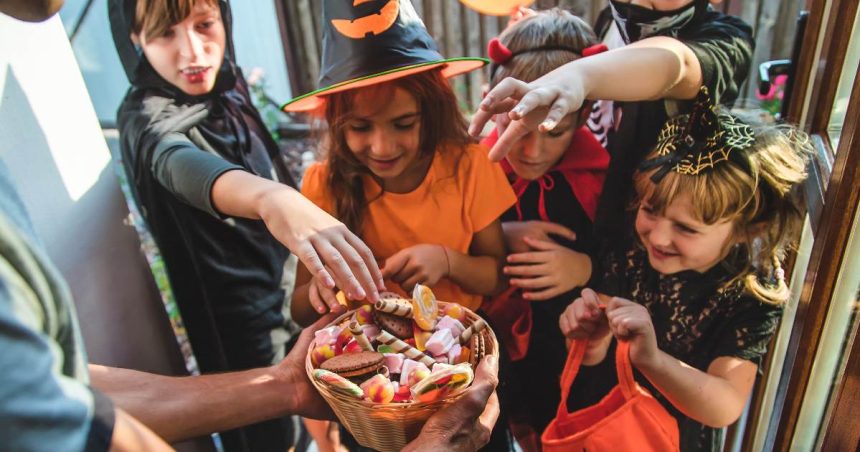As children around the country prepare to door-knock strangers in a quest for Halloween lollies and chocolates, a new survey by Zespri Kiwifruit has revealed 51 per cent of Australian parents – the equivalent to 1.7 million parents or guardians of children aged between five and 12-years-old – have disagreements with their child about junk food that leads to household tension.
Additionally, nearly half (47 per cent) of parents also say they find it difficult to manage or influence their child’s eating habits and the majority (95 per cent) have taken steps to limit their child’s junk food exposure. Digging deeper, six in ten (59 per cent) parents are now avoiding traveling routes with junk food advertisements and outlets and/or generally avoiding taking their kids to fast food or junk food restaurants.
With a growing number of Australian families celebrating today’s Halloween festivities, the insights Australian nutritionist Jacqueline Alwill has shared with EducationDaily come at a great time to help parents and carers get children back on the healthy eating track by educating them about the important nutritional benefits of healthier food choices.
Healthier Ways leads to better food choices
To help parents arm themselves with practical tips and information to face the healthy eating battle, Zespri Kiwifruit recently announced its Healthier Ways initiative, which allows Aussies to prioritise healthy eating by helping reduce fast food exposure while in transit – dashing between the many school pick-ups and activity drop-offs that are a part of many busy families’ lives.
Healthier Ways is a map tool that helps parents plan trips to reduce exposure to fast food and redirects them via other ways with less exposure.
“It’s no surprise that the majority of Aussie parents are worried about the junk food their kids are exposed to out of the home,” she says.
“Motivating kids to eat healthy is hard enough as it is without so many external factors at play”.
Pester power impact on parents takes a toll
Parents are feeling influenced to give in according to the survey results, with nearly nine in ten parents (87 per cent) saying they have felt pressured to give in to their child’s junk food request. Nearly six in ten (56 per cent) parents ranked seeing junk food advertisements and/or travelling past junk food outlets as one of the top three most common situations where they experience pester power.
“Children have a natural talent for influencing their parents, especially when it comes to food. The allure of colour and fun can make it challenging for parents to stick to healthier choices. It’s important to remember that many parents face this struggle; the goal is to find a balance. Parents often find themselves navigating a tough landscape when it comes to food choices, and by focusing on open conversations about nutrition and involving kids in meal planning, families can create a healthier environment without feeling pressured,” Alwill says.
Rising tensions in the home
Parents are seeing the impact of fast food on their child’s behaviour, with the research finding three in ten (29 per cent) parents saying their child feels frustrated or upset when they refuse to purchase junk foods and one in five (20 per cent) saying their child’s behaviour is immediately altered by certain junk foods.
Additional stats from the research:
- more than seven in every ten parents (72 per cent) say they are worried about their child opting
for junk food over fresh and healthy options - nearly two-thirds of parents (64 per cent) find it challenging to come up with healthy meals
or snack ideas when they are tired and time poor - nearly four in five (78 per cent) parents say their child understands that healthy food options
can be fun, flavourful and exciting - more than one in three (35 per cent) parents say they keep junk food out of sight at home while
one in five (19 per cent) limit invitations to parties or gatherings that heavily feature junk
food to limit their child’s exposure to junk food.
Healthier (ways) food options are available
While nearly two-thirds (64 per cent) of Aussie parents say they find it challenging to come up with
healthy meals or snack ideas when they are tired and time-poor, Alwill advises that keeping it simple and uncomplicated can be the best route for encouraging healthier eating habits in kids.
“Adding nutrient packed fruit and vegetables into your kids’ diet may be harder than it sounds but it really does pay off in the long run with persistence.”
“The Healthier Ways navigation tool by Zespri SunGold Kiwifruit works like a normal navigation system
but purposefully directs users on routes to see less fast food, taking them the healthier way instead,” Alwill told EducationDaily.
“Helping kids make healthier choices today sets them up for a lifetime of well-being. Many parents find it
challenging to stick to healthier food choices, so by involving kids in meal planning and food choices, families can instil the confidence in their own children to take greater responsibility over their health as they become more independent.”
She believes that, to help counter the plethora of junk food advertising young people are exposed to, parents should aim to have “really open conversations with kids about the importance of healthy foods being their main foods for fuel, and why they are, rather than the blanket ‘no, it’s bad for you’ statements that parents often respond with when their kids ask for junk food”.
“For example, ‘you need yoghurt to help your muscles grow, so you can run fast’; or ‘fruit is nature’s candy
and helps keep the lurgies away so you can spend more time playing with your friends’.
Alwill admits that saying ‘no’ can be hard, but says, “there are creative ways to change the conversation so it’s not about junk food requests, just like there are other ways you can change your route to school to avoid the junk and fast-food exposure too”.
Minimising the pressure of ‘pester power’
She told EducationDaily that the Healthier Ways initiative is “a great online navigation tool to help parents reduce their child’s exposure to junk food advertisements in transit which can often lead to pester power and tension amongst families”.
“Junk food is often seen as fun because it’s packaged up in bright colours and appealing mascots that attract our little ones’ attention. It’s also frequently associated with parties and special occasions, making it feel like a treat,” Allwill says.
“Parents can often fuel this idea by using junk food as a reward, though it is important to remember that balance is the goal.
“There are simple ways that parents can make healthier foods fun an exciting, such as using kiwifruit to create a delicious chocolate-dipped pop. Making simple, yet fun snack ideas such as this keeps kids both happy and healthy.
“I also love to get my kids involved in the kitchen, being creative with foods and making shapes with cut
fruit whenever they can, it’s a low-pressure activity and there’s no right or wrong.”
Alwill told EducationDaily that “it’s important to remove the ‘reward’ context from foods”.
“There are so many other ways we can reward our kids and giving them our time especially when they are young is one of the best rewards – for everyone involved.”
But Alwill says parents often feel pressure to give into their child’s junk food requests to avoid tension and arguments.
“Naturally, we want to keep our kids happy! It’s important to engage kids in choosing and preparing healthier snacks as they will be more willing to try new foods. It’s also important to remember that when kids see their parents choosing nutritious foods, they’re more likely to follow suit,” she says.
“What we teach our children will lay the foundation for their diet for life. Whilst giving in may feel easier, it sets you and them up for more demands down the track and developing less healthy food habits as they grow up.”
With junk foods being “typically high in refined sugars, saturated fats, additives and preservatives, which can
contribute to mood swings, hyperactivity, and poor focus in children”, Alwill says that by understanding how junk foods affect our kids, both parents and the kids themselves can feel better informed and supported to make healthier choices that support long-term wellbeing.
She says that a few methods of learning what’s in our food and why that helps to make a better or different decision to purchase it are:
- creating a habit of flipping the pack and looking at the ingredient list. If it’s full of ingredients you can’t recognise with numbers next to them (especially) then you pop it back and find a product with a minimal ingredient list
- shop in the outer aisles of the supermarket where the fresh ingredients are placed
- rather than take the kids to the supermarket where pester power peak, try to find a farmer’s market near to your suburb and take them to that instead. Farmer’s markets are an amazing way of kids understanding food in a different light, with story and play. They are also a great way to spend time together around food as a family, that isn’t in the home (or a fast-food restaurant).
Making healthy choices socially
When it comes to dealing with junk food’s lure at social gatherings and parties, Alwill says, “it’s important that parents promote a nutritionally sound yet balanced diet both in and outside of the home”.
“Social gatherings are always going to be part of life and there are simple ways to keep them enjoyable and fun whilst maintaining healthy habits. Parents can encourage their kids to choose a few favourite items, rather than indulging in everything available, be sure their kids are staying hydrated, and remind their kids that social gatherings are about connecting with friends and family, not just the food!
“If you have the time, give them a protein-rich meal prior to the party, this will satiate their appetite and help
balance their energy levels. I love a simple one like some home-cooked chicken drumsticks with carrot
sticks and a kiwi fruit.”
Alwill says parents can also help kids make healthier food choices by involving them in meal planning, grocery shopping, and cooking.
“This hands-on approach builds their confidence and interest in nutritious eating, helping to sustain healthy habits as they become more independent,” she told EducationDaily.
“Most importantly as well, if parents aren’t modelling the behaviour themselves then they can’t expect
their kids to follow,”
Role-model positive habits
And on Halloween, that may mean showing them that, although you also enjoy the occasional lolly or sweet treat, packing the bulk of the candy haul aways to be enjoyed over a period of time, rather than gobbled all at once.
“Having kids is a great time to really assess your own health and approach to nutrition because your children will mirror your habits and actions.”
To help enjoy healthy meals in your household, Alwill says parents can focus on whole foods and colourful vegetables and fruits to “bring it back to basics and focus on getting your 2 serves of fruit and 5 serves of vegetables”.
“Most Australians aren’t even anywhere near consuming the recommended two plus five daily and it’s one of the easiest strategies to tick nutrition boxes,” she told EducationDaily.
“Kids often love fruit in the morning so get that in at breakfast with their energising carbohydrates, such as
oats with dairy milk (porridge or muesli, for example) which contains protein for growth and development.
Pack kiwifruit in lunchboxes and after school bags, which are super easy and simple to have on hand as every-day snacks.”
She also suggests working with your child on “how to build out a wholesome lunch / lunchbox they’ll “actually” eat (nothing worse than lunchboxes coming home full, so communication is key) reinforcing the conversation around why healthy foods are important”.
“After school, get those healthy veggies and fruits into them first and top it up with a yoghurt or cheese, for
example, which increases calcium and protein intake for growing bones and bodies,” Alwill told EducationDaily.
“And when it comes to dinner, try to sit and eat as a family. Family meals don’t have to be complex, a roast
chicken with lots of veggies is quick to prep, delicious and full of nutrition. It’s cheaper than fast food options and brings families together for conversation about food, nutrition and of course, the day they’ve all had. This is a great time to de-stress and reconnect.”









